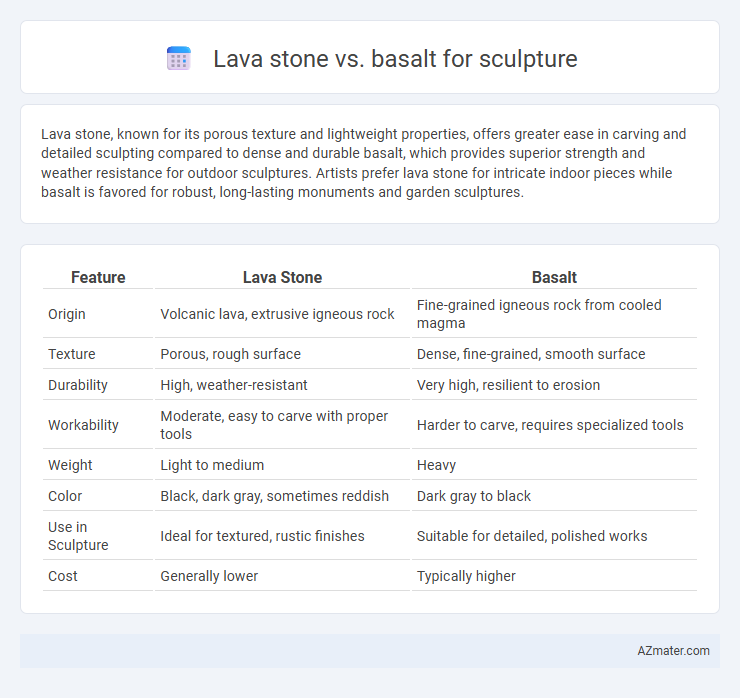Lava stone, known for its porous texture and lightweight properties, offers greater ease in carving and detailed sculpting compared to dense and durable basalt, which provides superior strength and weather resistance for outdoor sculptures. Artists prefer lava stone for intricate indoor pieces while basalt is favored for robust, long-lasting monuments and garden sculptures.
Table of Comparison
| Feature | Lava Stone | Basalt |
|---|---|---|
| Origin | Volcanic lava, extrusive igneous rock | Fine-grained igneous rock from cooled magma |
| Texture | Porous, rough surface | Dense, fine-grained, smooth surface |
| Durability | High, weather-resistant | Very high, resilient to erosion |
| Workability | Moderate, easy to carve with proper tools | Harder to carve, requires specialized tools |
| Weight | Light to medium | Heavy |
| Color | Black, dark gray, sometimes reddish | Dark gray to black |
| Use in Sculpture | Ideal for textured, rustic finishes | Suitable for detailed, polished works |
| Cost | Generally lower | Typically higher |
Introduction to Lava Stone and Basalt for Sculpture
Lava stone and basalt both originate from volcanic activity but differ in texture and porosity, impacting their suitability for sculpture. Lava stone is typically more porous and lightweight, allowing for intricate detailing and ease of carving, while basalt is denser and harder, providing durability and a polished finish ideal for outdoor sculptures. Artists choose between these stones based on the desired balance of workability and longevity in their sculptural projects.
Geological Origins: Lava Stone vs Basalt
Lava stone, formed from rapidly cooling molten lava on the Earth's surface, exhibits a porous texture due to gas bubbles trapped during solidification. Basalt, a dense, fine-grained igneous rock, originates from the slow cooling of magma beneath the surface or from lava flows that cool at a slower rate than typical lava stone. Both materials share a volcanic origin but differ in formation processes, influencing their suitability and durability for sculpture.
Physical Properties Comparison
Lava stone and basalt both possess dense, fine-grained textures that contribute to their durability and resistance to weathering, making them ideal for outdoor sculptures. Lava stone is typically more porous and lighter due to trapped gas bubbles, which can affect its strength and ease of carving compared to the uniformly dense, harder basalt. Basalt's higher compressive strength, averaging around 100-300 MPa, surpasses lava stone, providing enhanced longevity and structural integrity for large-scale sculptural works.
Workability for Sculptors
Lava stone offers a porous texture that enhances ease of carving, making it a popular choice for sculptors seeking detailed and intricate work. Basalt, being denser and harder, requires more effort and specialized tools to shape but provides greater durability and a smooth finish. Sculptors prioritize lava stone for its workability in fine detail, while basalt is favored for robust, large-scale sculptures.
Aesthetic Characteristics and Texture
Lava stone offers a porous, rough texture with natural pits and holes that enhance sculpture detail and create a rugged, tactile aesthetic, whereas basalt features a denser, smoother surface with fine-grained uniformity ideal for sleek, polished finishes. The dark, matte coloration of lava stone emphasizes rustic and organic visual appeal, while basalt's consistent black or dark gray hue lends itself to modern, minimalist sculptural designs. Both stones provide excellent durability but differ significantly in surface feel and visual impact, influencing artistic expression and sensory engagement.
Durability and Weather Resistance
Lava stone and basalt are both highly durable materials commonly used in sculpture, with basalt generally exhibiting slightly higher density and hardness, contributing to enhanced resistance to chipping and abrasion. Lava stone's porous structure allows for better weather resistance by enabling moisture evaporation, reducing the risk of cracking in freeze-thaw cycles. Both stones withstand harsh environmental conditions effectively, but basalt's tighter grain structure offers superior longevity in outdoor sculptures exposed to extreme weather.
Cost and Availability
Lava stone and basalt both offer durability and unique textures for sculpture, but their cost and availability vary significantly. Lava stone is generally more expensive due to its rarity and the specialized quarrying process, often sourced from volcanic regions like Italy and Hawaii. Basalt is more widely available and affordable, with abundant deposits worldwide, making it a cost-effective choice for large-scale sculptures.
Common Uses in Sculpture and Art
Lava stone, known for its porous texture and lightweight properties, is commonly used in sculpture for detailed carvings and ornamental art pieces that require intricate surface textures. Basalt, a dense and durable volcanic rock, is favored in monumental sculptures and outdoor installations due to its strength and resistance to weathering. Both materials offer unique aesthetic qualities and durability, making them popular choices in different styles and scales of sculpture and art.
Notable Examples and Artists
Lava stone, prized for its porous texture, is famously used in works by sculptors such as Isamu Noguchi, whose organic forms highlight the stone's natural ruggedness. Basalt, known for its dense, fine-grained composition, appears prominently in ancient and contemporary sculptures, with artists like Henry Moore exploiting its durability for large-scale outdoor installations. Notable examples include Icelandic lava stone statues and Egyptian basalt sarcophagi, showcasing the distinct aesthetic and functional advantages each volcanic rock offers in sculptural art.
Choosing the Right Stone for Your Sculpture
Selecting the right stone for your sculpture hinges on understanding the unique properties of lava stone and basalt; lava stone offers a porous texture and lightweight feel, making it ideal for intricate designs and detailed carvings. Basalt, known for its dense, fine-grained composition and durability, provides excellent resistance to weathering and is suited for outdoor monuments or heavy-use sculptures. Evaluating the sculpture's intended environment, desired texture, and longevity requirements ensures the choice aligns with both artistic vision and functional needs.

Infographic: Lava stone vs Basalt for Sculpture
 azmater.com
azmater.com